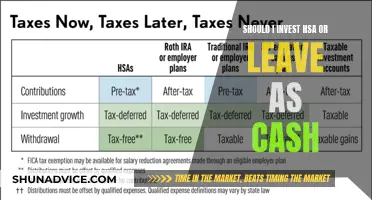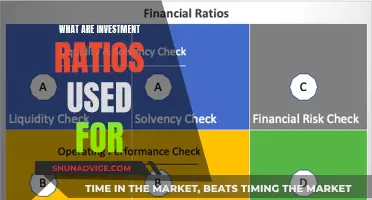
An investment ISA, or stocks and shares ISA, is a tax-efficient account for your investments. This means that you don't have to pay UK income tax or capital gains tax on any money you make from your investments. The value of investments can fall as well as rise, so you must accept the risk that you may get back less than you invest.
The total amount you can save into ISAs in the current tax year is £20,000. This is known as the ISA allowance. You can divide your ISA allowance across the four different types of ISAs: cash, stocks and shares, innovative finance or lifetime. However, the maximum you can put into a lifetime ISA is £4,000 each tax year.
| Characteristics | Values |
|---|---|
| Annual allowance | £20,000 for the 2024-25 tax year |
| Tax efficiency | No income tax or capital gains tax on investments |
| Investment options | Stocks, shares, funds, investment trusts, bonds, exchange-traded funds (ETFs), gilts, corporate and government bonds, Open Ended Investment Companies (OEICs), property, cash, peer-to-peer lending |
| Access to funds | Accessible at any time, but designed for medium to long-term investment |
| Eligibility | UK residents for tax purposes, crown servants working outside the UK or their spouse/civil partner, aged 18 or over |
| Transferability | Can be transferred to a new provider or between different types of ISAs |
| Loss offset | Losses on ISA investments cannot be used to offset capital gains on other investments |
| Dividend allowance | £500 tax-free dividend allowance |
| Deadline | Midnight on 5 April to open an ISA for the current tax year |
What You'll Learn

What is an investment ISA?
An investment ISA, or stocks and shares ISA, is a tax-efficient account for your investments. It allows you to buy, hold and sell investments without paying UK income tax or capital gains tax on any income or gains you make from your investments.
You can invest in a wide range of investments with an investment ISA, including:
- Individual company shares
- Bonds
- Property
- Other assets
- Collective investment funds
- Exchange-traded funds (ETFs)
- Investment trusts
- Gilts
- Corporate and government bonds
- Open-ended investment companies (OEICs)
The total amount you can save into an investment ISA in the current tax year (2024/2025) is £20,000. This is known as the ISA allowance and it resets at the end of each tax year on 5 April. You can invest all of your allowance in one investment ISA or spread it across multiple stocks and shares ISAs with other providers, or other types of ISA such as a cash ISA.
It's important to remember that the value of investments can fall as well as rise, so there's always a risk that you may get back less than what you invest.
Is Building Purchase with Cash an Investment Strategy?
You may want to see also

How do you open one?
To open an investment ISA, you must be a UK resident. You can get an Individual Savings Account (ISA) from peer-to-peer lending services, crowdfunding companies, or other financial institutions.
Step 1: How much do you want to invest?
The first step is to decide how much you would like to allocate to your new investment ISA. The ISA allowance for the 2024/25 tax year is £20,000, which can be split between different types of ISA accounts: cash, stocks and shares, lifetime, and innovative finance.
Step 2: Do it yourself or get someone in?
Next, decide whether you want to select and manage your investments yourself or have someone else manage your ISA portfolio. If you choose the latter, you can consider buying a pre-packaged 'fund of funds' or using a 'robo-adviser' service, such as Wealthify, Nutmeg, or Moneyfarm. These services use algorithms to manage portfolios at a lower cost than traditional wealth managers.
Step 3: Choose your provider
If you decide to manage your investments yourself, you will need to choose an investment platform or provider to open your ISA. Popular options include Hargreaves Lansdown, AJ Bell, Fidelity, and Charles Stanley.
Step 4: Determine your risk profile
Before investing, consider your objectives, time horizon, and attitude towards risk. You can complete an online risk questionnaire to help assess these factors.
Step 5: Choose your investments
You can open an investment ISA at any time during the tax year. When you open your account, the ISA provider will require personal information, such as your address, nationality, date of birth, phone number, and national insurance number. They may also ask for ID and proof of address.
Step 6: Account settings
Once your account is open, you may want to set up stop-loss and limit orders for stocks and investment trusts. You can also update your settings to specify preferences for things like paperless reporting and fund alerts.
Understanding the Ideal Cash-to-Investment Ratio for Your Business
You may want to see also

What are the tax benefits?
One of the primary reasons people choose an ISA is for its tax benefits. Here are the key benefits:
No dividend tax
You won't pay tax on dividends from shares held in an ISA. Outside of an ISA, only the first £1,000 or £500 you earn every year is free from tax, and beyond this, the amount you pay is based on your income tax band.
No capital gains tax
Any profit you make when selling investments in your stocks and shares ISA is free of Capital Gains Tax. The tax allowance for capital gains outside of an ISA wrapper is currently £12,300. For the 2023/24 tax year, the Capital Gains Tax (CGT) annual exempt amount will become £6,000 and will be fixed permanently to £3,000 from the 2024/25 tax year. Inside a stocks and shares ISA, you’ll pay absolutely none. For basic-rate taxpayers, capital gains tax is 10%. For both higher-rate and additional-rate taxpayers, it’s 20%.
No income tax
You pay no income tax on the interest or dividends you receive from an ISA and any profits from investments are free of Capital Gains Tax. Interest earned in a cash ISA is also tax-free.
No declaration on tax return form
If you complete a tax return, you do not need to declare any ISA interest, income or capital gains on it.
Tax-free savings
Your ISAs will not close when the tax year finishes. You’ll keep your savings on a tax-free basis for as long as you keep the money in your ISA accounts.
Marijuana Money: Investing the Green Rush
You may want to see also

What can you invest in?
The great thing about an investment ISA is that you can invest in a wide range of assets. This includes:
- Individual company shares
- Funds (allowing you to spread your money and risk across different investments)
- Investment trusts
- Bonds
- Exchange-traded funds (ETFs)
- Corporate and government bonds
- Open-ended investment companies (OEICs)
- Property
- Cash
- Peer-to-peer lending
You can either research and buy your own shares or invest in ready-made baskets of investments, which are called funds. Funds allow you to spread your money and risk across different investments, including shares, trusts and bonds.
Cash App Investing: Not for Everyone
You may want to see also

How much can you pay in?
The amount you can pay into an Investment ISA, or ISA, depends on the type of ISA and the tax year. The UK tax year runs from 6 April to 5 April the following year. For the 2024/2025 tax year, the maximum you can save across all ISAs is £20,000. This is known as your annual ISA allowance.
You can choose to pay your whole allowance into one type of ISA, or you can split it across multiple accounts. For example, you could save £15,000 in a cash ISA, £2,000 in a stocks and shares ISA, and £3,000 in an innovative finance ISA in one tax year.
If you have a Lifetime ISA, you can only put in up to £4,000 each tax year until you turn 50. The Lifetime ISA limit counts towards your overall ISA limit. So, if you put £4,000 into a Lifetime ISA, you would not be able to put more than £16,000 into other types of ISAs.
It is important to note that the ISA allowance limit applies to how much you can pay in during each tax year. There is no limit to how much money can be in an ISA, and you can have as many ISAs as you want as long as you meet the eligibility criteria and stay within your annual allowance.
Understanding the Relationship Between Cash and Investments
You may want to see also
Frequently asked questions
An Investment ISA, also known as a Stocks and Shares ISA, is a tax-efficient investment account. It allows you to invest in a wide range of investments such as shares, funds, investment trusts, bonds, exchange-traded funds (ETFs), gilts, and more. The value of your investments can increase or decrease over time, and any gains are usually exempt from UK income tax and capital gains tax.
You can open an Investment ISA with an accredited and regulated ISA provider. The process may vary depending on the provider, but you will typically need to meet certain eligibility criteria, such as being a UK resident for tax purposes and being 18 years or older. Some providers may also require you to have a current account with them.
The current ISA allowance for the 2024/2025 tax year is £20,000. You can invest all of this in a single Investment ISA or spread it across multiple ISAs, including cash ISAs, innovative finance ISAs, and lifetime ISAs. However, there are limits to how much you can invest in certain types of ISAs, such as the £4,000 limit for lifetime ISAs.
Yes, you can withdraw money from your Investment ISA at any time. However, if you withdraw money during a tax year and then reinvest it later, it will count towards your annual ISA allowance. It's important to remember that the value of your investments may have decreased since you initially invested, and you may get back less than you invested.







